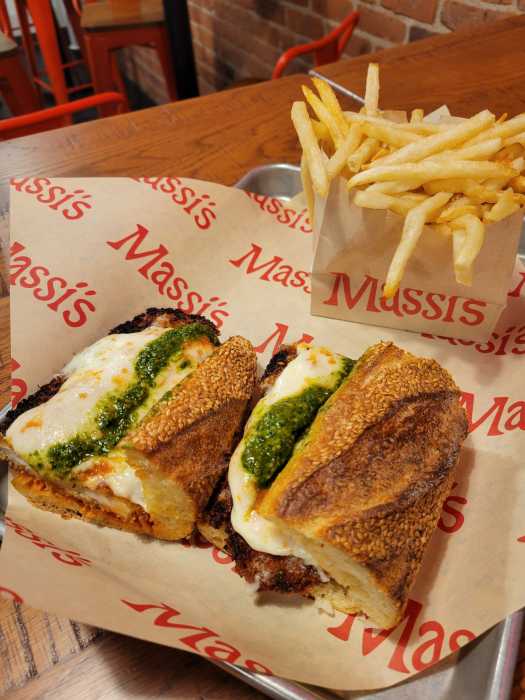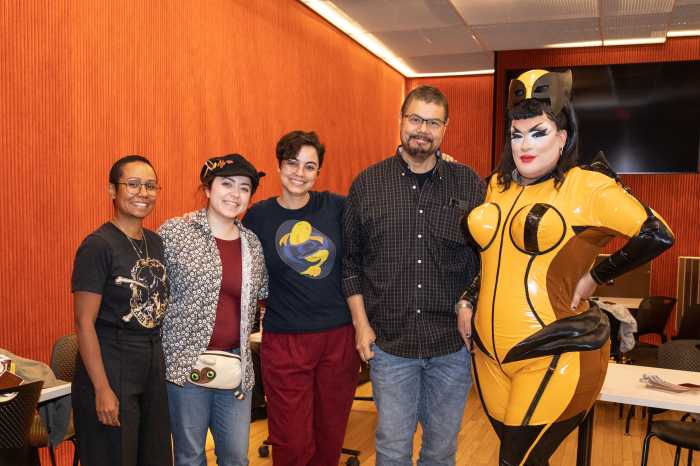BY BILL WEINBERG | Today I walked by the Bialystoker Center old folks’ home on East Broadway — or, rather, the building that used to house it. It now sits vacant, a note to former employees from the 1199 hospital workers’ union taped to the door of the stately 1920s edifice. The door is framed by a facade with symbols representing the 12 tribes of Israel and their names in Hebrew — designed to look like an archeological relic, it is now ironically on the way to becoming one itself.
A pending decision from the city Landmarks Preservation Commission may save the structure from demolition, but the Bialystoker home closed last year and new owners reportedly want to demolish it to build condos on the site. The home’s aging inhabitants were relocated to other facilities, outside of the neighborhood where they had lived their lives.
There are just a few other relics from the old Jewish Lower East Side that still survive on the surrounding blocks — most notably Kossar’s Bialys on Grand St., purveying that more soulful alternative to the bagel that also takes its name from the Polish city of Bialystok.
That city, precariously situated on the Russo-Polish borderlands, has seen more than its fair share of history. When my great-grandfather left at the turn of the century — arriving on the Lower East Side via London — Bialystok was part of the Russian empire, and among the most vibrant centers of European Jewry. Jews constituted the city’s majority, and a textile industry funded Jewish institutions and a Yiddish press. Just 50 years later, there would be far more Bialystoker Jews in New York than in Bialystok.
Rebecca Korbin’s book “Jewish Bialystok and Its Diaspora” tells us that the forerunner to the Bialystoker Center was the Bialystoker Bikur Holim — a Hebrew term meaning “charity” or “caregivers” — established in 1896 to assist immigrant Jews arriving in New York from the Eastern European city. A pogrom in Bialystok in 1906, with some 90 Jews killed, sped the exodus to New York. The city passed to the reconstituted state of Poland after World War I, and saw a renaissance of Jewish culture. But economic hard times there in the early 1920s (including a famine) saw New York’s Bialystoker Center organizing charity drives for kin back in the old country.
In 1927, the Center became an old-age home, and the currently threatened building was erected. But the Center continued to publish the Yiddish-language journal Bialystoker Stimme (Bialystoker Voice).
The Center and the community it anchored south of Grand St. became known as “New Bialystok” — a term that took on greater poignancy as the Nazis seized Poland, establishing a ghetto for Bialystok’s Jews in 1941. The instating of this new order was announced with the torching of Bialystok’s synagogue, with some 2,000 Jews inside. The following year, the Germans began deporting the ghetto’s inhabitants to the Treblinka death camp.
August 1943 saw a brief Bialystok Ghetto uprising, inspired by the one put down three months earlier in Warsaw. But with just one machine gun, a few pistols and some Molotov cocktails among several hundred would-be insurgents, the revolt did nothing to slow the extermination. By the time Russian troops liberated the city in July 1944, the Jewish population had contracted from perhaps 100,000 to just over 100.
There was actually an effort to rebuild an open Jewish community in Bialystok immediately after the war, as Jewish refugees who had fled east into Russia returned to the city. But an outbreak of new pogroms in Poland put an end to this, and nearly all of the surviving Jews departed — many for Palestine, with immigration restrictions now in place in the United States. (Contemporary leftists who view Zionism only as a neocolonialist conspiracy need to grapple with this history.)
The some 40,000 Bialystokers of Lower Manhattan became, more than ever, keepers of the flame. But there was also a Bialystoker community in Melbourne, Australia; a Bialystoker agricultural commune in Argentina; and an Israeli village of Kiryat Bialystok.
European totalitarianism has often — probably, too often — been invoked in polemic around the class and social struggles that have shaped New York’s cityscape. When I was a kid growing up in Queens in the 1970s, we once drove up to take a look at what had been my Italian mom’s own childhood neighborhood in the South Bronx — then devastated by arson and what was called “urban blight.” After viewing a landscape that resembled Berlin in 1945, my mom said, “It’s like we’re living in a Communist country.”
At the time, I didn’t quite get it, since it was clear to me even then that this was a social pathology endemic to capitalism. Only later, when I read Orwell’s “1984,” with its depiction of historical erasure, and learned of Stalin’s forcible relocations of whole ethnicities into Siberia and Central Asia, did I understand what she meant.
A decade later, I was hanging with squatters and anarchists on the Lower East Side, as rising rents and “redevelopment” were fueling displacement of the neighborhood’s working-class and Latino residents. A popular anarchist slogan was “gentrification is genocide.” After the Tompkins Square riot of August 1988, the graffito “1988 = 1933” appeared on neighborhood walls — a reference to the Reichstag fire and Hitler’s rise to power.
In the apocalyptic atmosphere of the neighborhood at that time — the homeless everywhere, the AIDS crisis at its worst, displaced residents forced into disease-ridden city shelters — the gentrification-is-genocide formulation didn’t seem that much of a stretch.
This rhetoric takes on a grim irony in the case of the Bialystoker Center. The Jewish presence has entirely disappeared from old Bialystok, and now the last remnants of the Bialystoker legacy in Lower Manhattan are threatened.
Actually, the gentrification never quite reached the Bialystoker enclave — until now. The Seward Park housing complex between Grand St. and East Broadway has served as something of a bulwark blocking gentrification’s advance from the rest of the Lower East Side. (My “Hagstrom Five-Borough Atlas” shows the “East Village” beginning at Houston St.) The Bialystoker community has dwindled due to age and attrition — those who could seeking the proverbial greener pastures. (My own great-grandfather was there but briefly; by the time I came into existence in the 1960s, he was already living in Brooklyn’s Ocean Parkway neighborhood.)
As the old Jewish community slowly shrinks in this enclave, the Chinese are rapidly expanding. The Bialystoker district has nearly been absorbed into Chinatown — Hebrew and Sinitic characters adorning adjacent storefronts. This juxtaposition is especially evident where the historic Moorish-themed Eldridge Street Synagogue stands alongside a storefront Buddhist temple. But the synagogue (while still consecrated) is as much a museum as a house of worship these days; the Buddhist temple is very much in vivo.
Two generations ago, Jews had receded from Alphabet City as Puerto Ricans moved in — a process sometimes punctuated by violence. (The social role of street crime in claiming and defending turf was exemplified in another ’80s graffito, “Mug a yuppie.”) Today, the last of the Puerto Ricans themselves are in rapid retreat before yuppie colonization — itself effected through the violence of police nightsticks.
In the old Bialystoker enclave, the dwindling Jews and the burgeoning Chinese alike stand to lose their turf if the “redevelopment” wave reaches this southern extremity of the Lower East Side. It would be a perverse twist if gentrification’s first foothold in the deepest part of the old Jewish L.E.S. — the triangle between Grand and Essex Sts. and East Broadway — should be at the site of the old Bialystoker Center. And even if condos are inevitably to occupy the site, destruction of the venerable building would compound the injury with a gratuitous insult to the Bialystoker legacy.
Hopefully, the Landmarks Preservation Commission will rule the right way, and fend off this final act of cultural cleansing.
Weinberg produces the Web sites WorldWar4Report.com and NewJewishResistance.com






































